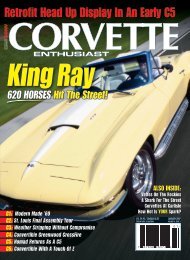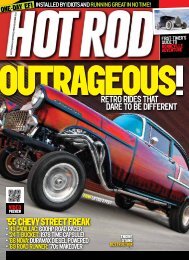Circle Track Crate Engine Technical Manual - Chevrolet Performance
Circle Track Crate Engine Technical Manual - Chevrolet Performance
Circle Track Crate Engine Technical Manual - Chevrolet Performance
Create successful ePaper yourself
Turn your PDF publications into a flip-book with our unique Google optimized e-Paper software.
Tune Up Specifications Continued<br />
Carburetor & Adjustments<br />
The Holley 80541-1 carburetor is rated at 650 cfm. <strong>Track</strong> testing showed the 650 HP series was the<br />
best carburetor choice for all three applications. A 750 cfm HP series carb was also tested. It<br />
didn’t make any more horsepower on the dyno and when it was track tested it was too rich and<br />
loaded up in the corners.<br />
Because all three engines make power well before 5500 rpm, the larger carburetor can actually<br />
hurt performance. The Holley HP series is designed with most racing modifications done. There are<br />
other very good high performance aftermarket carburetors available as well that may be used with<br />
proper testing and tuning.<br />
After installing your carburetor, make sure the float levels are set properly, the idle mixtures<br />
adjusted, and idle rpm set. Depending on the weather and altitude you may have to change the jet<br />
size up or down. Do not make large jumps in jet sizes without consulting the carburetor<br />
manufacturer or an engine builder. Most of the time only a couple of jet sizes is all that is necessary<br />
for proper performance. Make sure you take care of the carburetor when the season ends. Drain<br />
the fuel and put the carburetor in a plastic bag or sealed container. Do not leave it on the engine,<br />
the fuel will evaporate and leave a residue in the metering galleries.<br />
<strong>Engine</strong> Timing<br />
32-34 degrees of advance should be all that is needed. The combustion chambers are very efficient<br />
so it doesn’t take much timing to make power. Don’t run more than 34 degrees as detonation can<br />
occur.<br />
Fuel Requirements<br />
91-93 Octane Unleaded fuel is recommended. No need to run leaded fuel or 101-104 octane.<br />
Leaded fuel contaminates the oil and can foul the spark plugs. All three engines have compression<br />
ratios of 10:1 or less, so the higher octane is of little value. The valve seats are designed to run on<br />
unleaded fuel, plus unleaded fuel cost less and saves money each night. Some of the tracks &<br />
sanctioning bodies add traces of lead for “Off Road Use” which should not affect performance.<br />
Headers<br />
In GM testing, the engines were tested with stepped headers. The headers were 1 5/8” primary<br />
tubes 10” long, and then stepped to a 1 3/4” tube. The total length was 33” with a 3 1/2” collector.<br />
All three engines have efficient combustion chambers and exhaust ports. Therefore, it’s normal to<br />
see flames out the back of the car during deceleration. The more efficient the headers the worse the<br />
flames will be. Most 2bbl classes need headers that are designed to scavenge the exhaust to make<br />
power and this pulls more fuel through the engine. That is not necessary when using the<br />
recommended 4 bbl carburetor on GM engines.<br />
Recommended Oil<br />
GM recommended Mobil 1 synthetic oil for all three engines. Extensive testing has proved that<br />
synthetic oil provides better lubrication qualities under extreme conditions and lasts longer.<br />
Page 12




